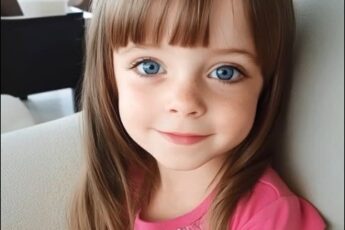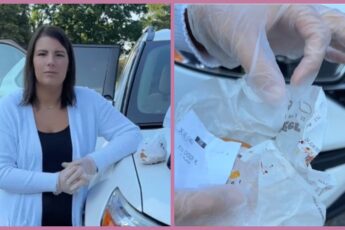Just weeks after the joyous news of Millie Smith and Lewis Cann expecting twin baby girls, their happiness was shadowed by the heartbreaking reality that only one would survive.
On April 30, following a precarious 30-week pregnancy, Smith gave birth to identical twins, Callie and Skye. Tragically, Skye’s life lasted a mere three hours.
In the neonatal intensive care unit (NICU), Callie slumbered alone in the incubator, her parents, torn between love and grief, keeping a vigilant watch over her. Amidst the beeps and hums of the unit, a mother of healthy twin newborns inadvertently remarked to Smith how fortunate she was not to have two babies.
Посмотреть эту публикацию в Instagram
Overwhelmed by the weight of those words, the new mother found herself at a loss for a response. But then, a realization dawned upon her: Skye’s legacy would be to offer solace to families grappling with similar losses, embodied in the form of a purple butterfly.
In November 2015, Millie Smith and her partner Lewis Cann received the news of their impending parenthood. With twins running in the family, Smith had a premonition of having two children, and ten weeks later, medical confirmation arrived: they were expecting identical twin girls.
Yet, within a mere fortnight of the elation of doubling their family, the British couple’s joy was shattered when they received the devastating news that one of their babies had a fatal condition, destined not to survive beyond birth.
Reflecting on the moment of the scan, Smith recounted, “The doctor’s silence spoke volumes. While I reveled in the sight of our little ones, her quietude was telling. Both Lewis and I sensed immediately that something was amiss.”
Doctors delivered the heart-wrenching diagnosis: one of the babies had anencephaly, a rare condition affecting approximately one in 4,600 babies in the United States, according to the Centers for Disease Control and Prevention (CDC). Anencephaly is a severe birth defect characterized by the absence of parts of the brain and skull, with the prognosis being that “almost all babies born with anencephaly will die shortly after birth.”
Faced with the knowledge that one of their babies would pass away imminently after birth, and with considerable risks involved for their other child, the couple resolved to proceed with the exceedingly high-risk pregnancy.
In the ensuing months, Smith and Cann bestowed names upon their twins, Skye and Callie. “We knew that Skye deserved to be named before she entered this world,” Smith remarked. “Aware that her time with us would be fleeting, I wanted her to bear a name during those precious moments.”
The meaning behind “Skye,” she explained “was somewhere we knew she would always be, that we could look up at the sky and remember our baby.”
Посмотреть эту публикацию в Instagram
When Smith went into labor unexpectedly after only 30 weeks, requiring an emergency C-section on April 30, the couple found solace in the presence of a “bereavement midwife” during the birth. They were ushered into a special room known as the “Daisy Room,” designed for families to spend precious moments with their baby before and after their passing.
“When the girls entered the world, both cried. It was a monumental moment, as we had been prepared for Skye to remain silent and still,” recalled Smith, grateful for the three hours they had with Skye before her passing. “We held Skye close as she slipped away. It was the most agonizing moment of our lives. I’ve never experienced heartbreak like that before. Yet, I’m proud that she fought so valiantly to be with us.”
Due to her premature birth, Callie required NICU care to gain strength. In the unit, three other sets of twins were also undergoing treatment.
“While most nurses were aware of our situation, over time, Skye became a taboo topic. After about four weeks, it seemed as if everyone had forgotten, leaving the families around us unaware of our loss,” recounted Smith.
One morning, a frazzled mother with twins in the NICU innocently remarked to Smith how “lucky” she was not to have twins.
“None of the other parents knew about Skye or what had happened. The comment was innocent, almost a jest… They couldn’t have known that we had, at one point, anticipated having two,” Smith explained. “But those words nearly shattered me. I fled the room in tears, and they had no inkling why. I couldn’t bring myself to explain. A simple identifier could have spared us that pain.”
In that moment, Smith resolved to create something that would advocate for parents who had recently lost a baby, ensuring such misunderstandings would never recur.
Посмотреть эту публикацию в Instagram
She crafted a poster for the NICU, clarifying to both hospital staff and visitors that any incubator adorned with a purple butterfly indicated the loss of one or more babies in a set of multiples.
“I chose butterflies as a symbol, representing the babies that fluttered away, and the color purple for its gender-neutrality,” explained Smith.
The purple butterfly initiative, now operating under the Skye High Foundation, has proliferated to hospitals across numerous countries worldwide.
“Happy 6th Birthday to Callie and Skye. Six whole years since we welcomed you to the world 💜,” shared The Skye High Foundation on Friday, April 29, 2022.
Callie, now a vivacious and joyous seven-year-old, cherishes the memory of her twin sibling through purple butterfly cards and other endeavors aimed at aiding families with babies like Skye globally. These purple butterflies manifest in various forms, including ornaments, cards, blankets, stuffed animals, and more.
“While I may never be able to prevent such tragedies, establishing support groups and implementing measures like these stickers can make a significant difference. It’s the most challenging ordeal anyone can face,” remarked Smith.
Losing a child, regardless of age, is an immense burden for any parent, and the world is truly fortunate to have individuals like Millie Smith dedicated to aiding others in their time of need.
Please share this story so others know what a purple butterfly next to a newborn means!







